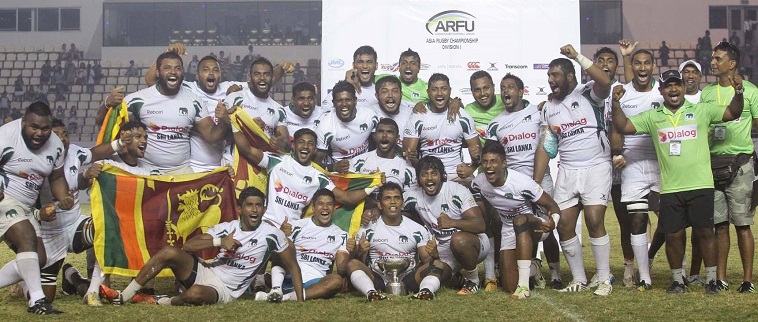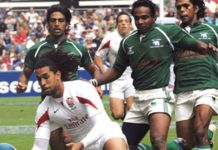The Sri Lanka Rugby team picked up the title of Division one Asian Rugby champion over the course of the last week beating Kazakhstan 35-15 and the Philippines 27-14 in Manila. Although Sri Lanka has the bragging rights as division one it does not mean they are the pinnacle of Asian Rugby.
There is a long way for Sri Lanka to go in order to achieve the ultimate goal of consistently making an impact in Asian competition. There is also the task of qualifying and maintaining a slot in the region’s elite Rugby competition. Sri Lanka now has the right to challenge the 3rd place finishes of the Asian top 3 competition which consists of Japan, Hong Kong and Korea. As proved last year Sri Lanka is still a stretch away from the top three teams in Asia.
The powers that be, need to take a close look at the team’s performance as a whole over the last week and not just focus on the result. Although Sri Lanka won both their games fairly convincingly, the level of rugby left a lot to be desired. Sri Lanka’s lackadaisical performance against Kazakhstan in the first game cannot be ignored. Kazakhstan fielded a mediocre team that looked completely disjointed in addition to the fact they were playing with 14 men for majority of the game. Sri Lanka started well but relaxed after scoring a couple of tries early. That was a game that on paper Sri Lanka should have won much more compellingly. In the final against the host Sri Lanka put on a slightly better performance, but had the Volcanoes been in better form, the Tuskers would have struggled. It was pure fortune that the Pilipino side had not trained together for more than a week and had no structure in defense. Had they been at full strength the result would have been quite different.
Although there were many flaws in the Sri Lankan performance it must be stated that there were also many positives. Firstly it must be mentioned that Sri Lanka had some good tactical influence which has to be attributed to the returning coach Johan Taylor. Taylor who is one of Sri Lanka’s most successful coaches clearly had prepared to the best of his ability and had a clear structure in mind. For the first time Sri Lanka seemed well structured defensively and had improved massively in the tackles most of the time. The introduction of the much bigger and physical foreign players in the domestic system has certainly helped the smaller Sri Lankans get accustomed to getting hit hard. Although they did fall off a few tackles, and still struggled a bit to match the physicality of the bigger oppositions, they were much better than in previous years.
It also appeared the tight five has finally got some size and power with the combination of Henry, Achala Perera and Kishore Jehan up-front with the monstrous Dimithri and Sean Wijesinghe adding some power in the locks. Unfortunately they still writhed for consistency in the scrums winning a majority but on the odd occasion struggling. The lineouts on the other hand were much better in the final as Sharo was dominant in the air and Achala Perera was extremely accurate with his throws. As for the third row, whilst the traditional combination of Dhanushka Perera, Rajapakse and Muthuthanthri was absent for the Tuskers the much younger combination of Sohiru Anthony, Sharo Fernando and Buwaneka Udangamuwa was more competent and with more experience will certainly be a force to reckon with. Sri Lanka did however seem to struggle a bit around the breakdown. They seemed to always lack numbers in the breakdown and against stronger opposition would have most certainly been swept away.
In the back line the senior combination between Roshan Weerarathne and Fazil Marija was easily the difference between Sri Lanka and their opponents. Marija was almost flawless in attack as he carved through the defense like a knife through butter time and again. This front-foot ball gave the backs chances to open up defenses, although they failed to convert on many an occasion. The most valuable player award went to Dhanushka Ranjan who scored three tries. Ranjan has seriously stepped his game up over the course of the last year and has made the number 13 jersey his own. He was absolutely lethal in open play and was devastating running off the shoulder of Marija. The back three on the other hand with the exception of Rizah were fairly insignificant in the two games. Rizah was meticulous in his kicking out of hand and as always was positioned well at the back. His place kicking although less than his usual best, was good enough to get Sri Lanka through and his last kick of the tour summed up his quality. Sandun Herath on the other hand who has been rated as one of the best wingers in Sri Lanka barely got his hands on the ball and didn’t seem to look for work. Dinusha Chathuranga and Lavanga Perera who shared the opposite wing were also rarely involved in the game.
All in all Sri Lanka’s on-field performance was satisfactory but nowhere near where it needs to be. Sri Lanka is certainly on the right path and politics and personal agendas allowing, is certainly a few years away from reaching their ultimate goals. Therefore the question arises as to what Sri Lanka needs to do both on and off the field to compete with the big guns of Asia?
This article may seem detractive in the wake of a good outcome for the Tuskers, but in no means is meant to plague the team with disparagement but is a critical look at Sri Lanka’s performance and is meant to be simple constructive criticism.





















